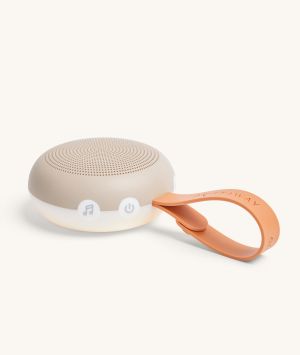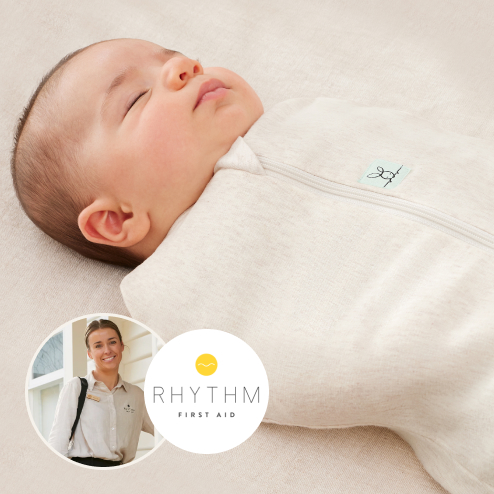White Noise Machines for Adults - What are the Benefits?
28 July 2023 Newborn Sleep Infant Sleep Toddler Sleep Preschooler Sleep

White noise, most commonly known as soothing or calming sounds, has become increasingly popular for adults looking to improve sleep quality, concentration levels and overall relaxation. White noise has long been associated with it’s use for babies to promote sleep, but incorporating white noise into your everyday adult life has many health benefits, such as aiding in relaxation, mindfulness, and overall well being.
Whether used for your sleep routine, study routine or whilst at work, the constant blend of frequencies, provides a gentle background hum that effectively masks other distracting sounds in the environment. With its ability to drown out external disturbances and create a backdrop sound, white noise has become a cherished tool for many adults, both during waking and sleeping hours.
White, brown and pink noise: what's the difference?
Although white noise is commonly spoken about, you may have heard the terms pink noise and brown noise. These sounds can equally be as beneficial in improving sleep, relaxation and concentration. So what is white, pink and brown noise?
White Noise
Most people are familiar with the term white noise, often describing it as a ‘static sound’ similar to those heard from a radio or TV. White noise uses both low and high sound frequencies from across the audible sound spectrum to create a steady noise with no specific pitch.
Examples of white noise include:
● Static sound
● Fans
● The hum of an air conditioner
Pink noise
Pink noise is similar to white noise, however, pink noise uses deeper and lower sound waves to create a noise lower in pitch. This sound is often viewed as softer and more soothing for adults.
Examples of pink noise include:
● Ocean
● Rain
● Nature
Brown noise
Brown noise possesses an even deeper sound with lower frequencies compared to those of white and pink noise.
Examples of brown noise include:
● Heavy rain
● A running shower
● Thunder
● Crashing waves
It’s important to note that the benefits of white, pink and brown noise can vary for each individual, and the type of sound you use can be tailored to suit your needs and preferences. White, pink and brown noise can be used in combination or individually.
How do white noise and other sleep sounds help improve sleep in adults?
At night, we often close our eyes ready to sleep, and although our body feels tired after a long day at work, the minute we close our eyes, our mind begins to race, thinking about absolutely everything and anything (for me, it’s often to do with work) including things that you might feel stress or anxiety about. Similarly when we are stressed or anxious, nightime can become daunting as you prepare for yet another night of minimal rest. Or maybe it’s one of those nights where you can’t get to sleep and although you try everything you can to fall asleep all you can do is watch the clock and count down the hours until you wake up, dreading how tired you are going to feel tomorrow.
Using white, pink or brown noise as part of one’s bedtime routine has been shown to improve quality of sleep in adults. (Ebben, Yan & Krieger, 2021).
Sleep is a basic human need and is essential for good health, good quality of life and performing well during the day. The World Health Organization estimates that approximately nearly 25% of the population suffers from disturbed sleep due to environmental noise. (Ebben, Yan & Krieger, 2021).
Sleep has a direct relationship with both our physical and mental health - from the physical effects of sleepiness (fatigue, hypertension and cognitive impairment, including deterioration in performance, attention and motivation) to mental health complications, such as limiting our ability to handle stress and emotions. Poor sleep can cause us to not function as our best self the next day. Often, sleep deprived people can fall asleep at work, lack concentration and become easily irritable and frustrated.
Using white, pink or brown noise helps create an environment that is optimal for promoting deep, restful sleep. This is because the constant blend of frequencies creates a relaxing background sound that effectively masks other distracting sounds when sleeping, such as cars passing or dog barking, and prevents unnecessary waking due to environmental factors.
Using sleep sounds can help your body develop a sleep cue. When the sound is playing, our body knows to prepare for rest.
New mums, this one’s for you:
How can white noise help you and your baby postpartum?
As your baby grows, the sounds of the womb such as your voice, heartbeat and swishing of amniotic fluid become their familiar sounds. Once your baby is birthed earthside, a lot of changes happen, from unfamiliar sounds flooding their ears to new sensations of hands, nappies and clothing touching their delicate skin. The early stages of postpartum are a big adjustment for both you and your baby. Sleep deprivation and baby blues are in full swing, and at times it can feel as though getting your newborn to sleep (so you can sleep, too) seems impossible.
Using white noise sounds such as a heart beat, shooshing or water sound helps to mimic the sounds heard within the womb. A baby’s hearing is developed from 18 weeks gestation. This will help relax your baby and promote sleep meaning you get to rest, too.
In the early postpartum days, you’re having to wake to feed your baby every 3-4 hours, and sleep consists of 2-4 hourly blocks. This is where using white noise can be so beneficial for both you and your baby. White noise can help a sleep- deprived parent improve their sleep by promoting a deeper and more restful night sleep even when sleep is limited.
Does white noise help you study?
For many of us, studying can be challenging at the best of times. Distractions seem to be never ending, and procrastination levels are at an all time high. Whether you’re at school, university or learning something new for work, white noise has been shown to improve your study levels (Awada, Becerik-Gerber, Lucas, et al., 2022).
White noise creates an optimal study environment by providing ongoing background noise that reduces and mutes multiple auditory stimuli, making it easier for your brain to filter out distractions and maintain a state of concentration.
Does white noise improve concentration?
White noise helps to improve our concentration levels and expand our duration of focus on a task, as well as improve our retention of new information.
When we’re studying or working, playing consistent and relaxing sounds wthin the background helps to mask disrupting sounds within our environment, such as conversations, traffic, dogs barking or background music. Creating a constant auditory environment promotes a sense of tranquility, which improves our mental clarity and overall concentration levels.
White noise can be extremely helpful for those who study or work within noisy environments to allow them to fully immerse themselves in their studies or work without being disturbed. This allows them to improve their cognitive capabilities, such as learning, thinking, reasoning, remembering, attention, perception and executive function, which are required whilst at work to overcome challenges and create high-quality work.
My own journey with white noise
As a midwife, shift work can be very disruptive to my sleep routine, which can negatively impact my concentration level, mood and ability to perform at a high level day to day. Shift workers often have no control over their routine and whether they work day shifts, afternoon shifts or the dreaded night shift. Prioritizing my sleep is extremely important to me to ensure that I’m refreshed, alert and ready for what the day at work brings (always hoping to help welcome a baby into the world). Since using the ergoPouch Drift Away White Noise Machine, my sleep has never been better. I use it in my everyday life when preparing for sleep, especially for naps before night shift as a sleep cue, and I can honestly say it has seriously improved my quality of sleep helping me feel refreshed for the day ahead.
Overall, using white, pink and brown sounds in our day to day adult lives has so many added health benefits. From improving our quality of sleep at night to our executive functioning at work and whilst studying, white noise is a simple yet cost effective way to make a positive change to your life and sleep. Give it a go!
References:
Awada, M., Becerik-Gerber, B., Lucas, G. et al. (2022)Cognitive performance, creativity and stress levels of neurotypical young adults under different white noise levels. Sci Rep 12, 14566. https://doi.org/10.1038/s41598-022-18862-w
Ebben, M. R., Yan, P., & Krieger, A. C. (2021). The effects of white noise on sleep and duration in individuals living in a high noise environment in New York City. Sleep medicine, 83, 256–259. https://doi.org/10.1016/j.sleep.2021.03.031
Riedy, S. M., Smith, M. G., Rocha, S., & Basner, M. (2021). Noise as a sleep aid: A systematic review. Sleep medicine reviews, 55, 101385. https://doi.org/10.1016/j.smrv.2020.101385
World Health Organization. Regional Office for Europe. (2004). WHO technical meeting on sleep and health: Bonn Germany, 22–24 January 2004. World Health Organization. Regional Office for Europe. https://apps.who.int/iris/handle/10665/349782
About the author
Monique Maitland is a Midwife and Nurse, Founder of The Middee Society & Host of Middee - The Podcast, who is passionate about supporting families to best prepare for the many highs and lows that come with parenthood.
With love,
eP














